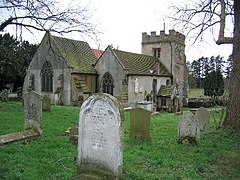Parish of Harefield
| Parish of Harefield Diocese of London | |
| Serving in: | Harefield |
|---|---|
| County: | Middlesex |
| Vicar: | Martin Davies |
| Parish church: | St Mary's, Harefield |
| Details | |
| Address: | The Parish Office, c/o The Vicarage, 28 Countess Close, |
| Tel.: | 01895 825960 |
| E-mail: | stmarysharefield@gmail.com |
| Website: | http://www.stmarys-harefield.com/welcome.htm |
The Parish of Harefield serves the village of Harefield in the very north-west of Middlesex and extends across all the farms southward to the edge of Ickenham. It is the largest parish in the Diocese and in the County.
Harefield is the most rural part of Middlesex, the village itself retaining a countryside setting with farmland on all sides despite the closeness of the metropolis, which it serves as a commuter village. Harefield has sprung developments, particularly South Harefield, also within the parish.
Contents
The Parish Church
St Mary's Parish Church is Harefield’s oldest building, and has been its spiritual heart for centuries. The Church, sited in Church Hill at the edge of the village was built over the course of several centuries, beginning in the twelfth century. It has been described as “the Westminster Abbey of West Middlesex” because of its wealth of monuments.
History
At the Domesday Survey of 1086 Harefield had a priest, and therefore presumably a church which was probably on the present site, but no trace of such a building remains.
The patronage of the church was first owned by the Knights of St John of Jerusalem, the Hospitallers, who had a priory half a mile away near the present Moorhall Road, and under whom it was a "peculiar", exempt form the jurisdiction of the bishop. The Order of St John was dissolved in England at the Reformation and the right of presentment passed to the Newdigate family, who for many years were also Lords of the Manor, but it remained a private peculiar until 1847, when was absorbed by the Diocese of London. St Mary's became a parish church in 1898. The Newdigate family remain the patrons of the living to the present day.
- Twelfth century: the church had a chancel and a nave, traces of which remain in the west wall.
- Thirteenth century: the present chancel was built (an original lancet window of which pierces the north wall). A north aisle or chapel was added at about the same time.
- Fourteenth century: the present nave was built. Also the front two bays of the south aisle were added as a chapel, known as the Brackenbury Chapel.
- Sixteenth century: the present north aisle and the Breakspear Chapel were built and the tower added, which houses six bells. The earliest bell still hanging is dated 1629.
- Eighteenth century: a major restoration funded by the Newdigates under the direction of Henry Keene, an architect to the family. The chancel arch was widened and its roof and east window replaced; the chancel stalls were erected, and the gallery installed.
- 1840s: the south aisle was extended to its present length (and several monuments moved in consequence). The heraldic glass probably dates from this time. The Porch was moved to its present position on the north side of the church.
Features
Unusual features of the church are the raised chancel, the three-decker pulpit, the gallery above the north aisle
The church bears a wealth of monuments and hatchments to the Newdigate, Ashby and other families.
The Australian Chapel
The Australian Chapel in the north aisle commemorates Australian soldiers of the Great War buried in the Anzac Cemetery. The Australian flag which hangs here was presented by the Australian Children’s Patriotic League after the Great War.
The chapel was dedicated in 1951 but was created in the sixteenth century and was previously known as the Breakspear Chapel.
The Brackenbury Chapel
The Brackenbury Chapel in the south aislewas created in the fourteenth century. It has no known connection with the family of that name, though there is a Brackenbury Farm in the parish.
The Anzac Cemetery
The Anzac Cemetery is an extension to the churchyard made during the Great War. Here are buried soldiers of the Australian and New Zealand Army Corps who died of wounds at Harefield Hospital.
During the First World War Harefield Park was offered by the owner, Charles Billyard Leake, as a hospital to the Ministry of Defence of New South Wales. For the duration of the war casualties from the Australian Forces from Gallipoli and the Western Front were treated at the newly created Harefield Hospital. Many of the wounded died; 111 men and one nursing sister were buried with military honours in the churchyard.
The village school lent its Union Flag for these burials. After the war the flag was presented to the last Commanding Officer of the Australian Hospital and was laid up in Adelaide High School. The Australian Children’s Patriotic League presented in return a new Union Flag and an Australian Flag to Harefield School. The Australian flag hangs in the Australian Chapel.
In 1921 began the annual ceremony in which the children from the school put flowers on every grave in the cemetery. This is followed by a Commemorative Service to which we always invite representatives from the Australian High Commission. Anzac Day, 25th April, has become a most significant annual event in the Harefield calendar.
